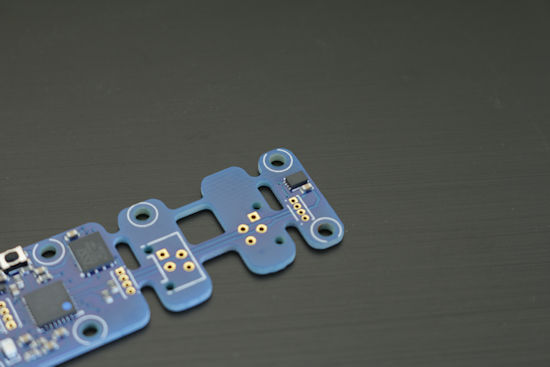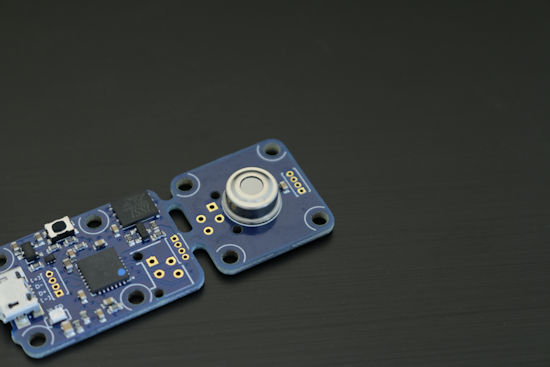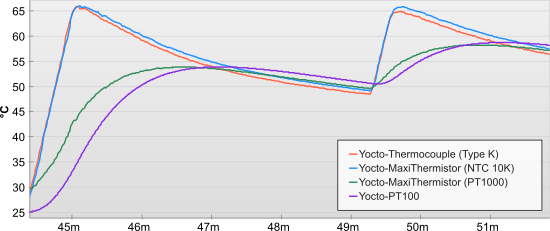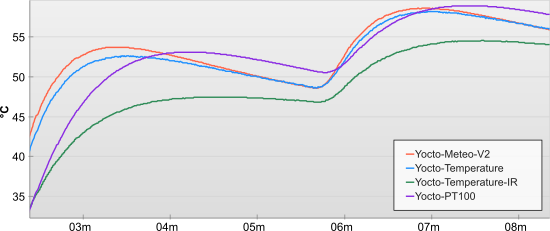![]() More than half of the Yoctopuce devices in the Environmental Sensors category perform temperature measures in one way or another. Why are there so many ways to measure the temperature and what are the advantages and disadvantages of each method?
More than half of the Yoctopuce devices in the Environmental Sensors category perform temperature measures in one way or another. Why are there so many ways to measure the temperature and what are the advantages and disadvantages of each method?
Measuring techniques
The Yocto-Thermocouple
A thermocouple is a pair of wires made of two specific and distinct metals, soldered together at one end. A physical phenomenon called Seebeck effect creates a small electric voltage between the two wires at the other end which depends on the temperature at both ends. If you connect a thermocouple to a Yocto-Thermocouple, the module can measure the temperature at one end as well as the electric voltage, and deduce the temperature at the other end of the thermocouple. There are several types of thermocouples, depending on the metals that are used. You must therefore configure the thermocouple type that you use in the module so that it properly computes the temperature.

Thermocouple probes
The advantages of the thermocouple technique:
- It can perform a remote measure at a specific location.
- Thermocouples are usually not expensive. With the Yocto-Thermocouple, you receive two type K thermocouples which can measure up to 260°C.
- With the appropriate probes, you can measure very high temperatures, above 1000°C.
- The measures are very reactive (latency below the second).
The disadvantages of the thermocouple:
- Despite a good sensitivity to variations, the absolute accuracy is not very good, about 1-2°C / 1%.
- The characteristics of thermocouples can drift over time.
- Measures can be disturbed by ambient electromagnetic noise.
- A thermocouple can be extended only with the same kind of thermocouple wire and you cannot solder it with tin.
The Yocto-MaxiThermistor
Thermistors are a temperature probe family based on materials whose resistance changes depending on the temperature. The two sub-families are NTC thermistors, for which the resistance decreases when the temperature rises, and PTC, for which the resistance grows with the temperature. When the two wires of a thermistor are connected to the input of a Yocto-MaxiThermistor, the later can compute its resistance and deduce the temperature at the sensitive location. As there are many variants of the NTC and PTC thermistors, you must configure the parameters of your thermistor in the device. The most commonly used thermistors have a resistance varying from a few KΩ to a few tens of KΩ, which quite suites the Yocto-MaxiThermistor.

NTC thermistors
The advantages of the thermistor technique:
- It can perform a remote measure at a specific location.
- It is very cost effective: thermistors are cheap and can be extended with any electrical wire. NTC thermistors are provided with the Yocto-MaxiThermistor.
- The measure has a low sensitivity to electromagnetic noise, as resistances above 1KΩ allow the use of voltages above 1 Volt to perform the measure.
- Thermistor characteristics remain stable on the long term.
The disadvantages of the thermistors:
- The usable measuring range of NTC thermistors is usually limited (for example -15°C to 75°C).
- Thermistors are not as reactive as thermocouples
- Absolute accuracy is not very good (typically 1 to 2 °C), except if you take care to calibrate each thermistor individually.
The Yocto-Thermistor-C is a variant of the Yocto-MaxiThermistor using a common wire for the 6 inputs. The Yocto-Bridge and the Yocto-MaxiBridge also contain a temperature measure by thermistor.
The Yocto-PT100
Pt100 probes are a very particular type of PTC thermistors based on pure platinum. Its characteristics are so well defined that they are part of the International Temperature Scale (ITS-90). The resistance variation of the Pt100 is much lower than that of NTC thermistors, which allows it to be used on a much larger range, which can go from -200°C to 500°C.

Pt100 probes
The advantages of the Pt100 technique:
- It provides an excellent absolute accuracy.
- It enables you to perform remote measures.
- It is not very sensitive to electromagnetic noise.
The disadvantages of the Pt100:
- The price... the more accurate, the more expensive!
- To obtain a good accuracy, you need four wires to deport them.
- They do not withstand as high temperatures as thermocouples.
- The size of a Pt100 probe is at least of a few millimeters.
- The latency of a Pt100 probe is higher than that of a thermocouple (a few seconds)
- A Pt100 probe can be damaged by repeated extreme temperature variations.
What about Pt1000?
In the industrial world, PTC thermistors of type Pt1000 are sometimes used. They follow a curb very similar to that of Pt100 and share therefore the advantage of a large measuring range, but the higher resistance enables the use of two wires instead of four without loosing too much accuracy.
The adequate module to measure the temperature with a Pt1000 is the Yocto-MaxiThermistor. Until now, you had to enter the whole temperature curb of the Pt1000 in the module configuration, but from firmware 35560 onward, you can simply select the Pt1000 type and the module accurately computes the corresponding temperature.
If you want to perform a temperature compensation for the measures of a Yocto-Bridge or a Yocto-MaxiBridge in an environment where the temperature goes below 0°C, a Pt1000 advantageously replaces the provided NTC thermistor, which is better suited for inside temperatures.
The Yocto-Temperature
The Yocto-Temperature uses a digital chip which directly contains a Pt100 with the aim to measure its own temperature, and thus implicitly the ambient temperature.

The Yocto-Temperature sensor
The advantages of a measure embedded in the chip:
- A good absolute accuracy (0.25°C)
- A cheap solution
- An insensitivity to electromagnetic noise.
The disadvantages of a measure embedded in the chip:
- A measure of the ambient temperature only (not intended for contact measurement).
- The measure latency is not negligible, because of the thermal inertia of the PCB.
The Yocto-Meteo-V2
The Yocto-Meteo-V2 is specifically intended for the measure of ambient conditions. Its embedded temperature sensor directly measures the air in contact with the chip.

Temperature and humidity sensor of the Yocto-Meteo-V2
The advantages of an embedded sensor that measures the air on contact:
- An excellent absolute accuracy (0.1°C).
- An insensitivity to electromagnetic noise.
The disadvantages of an embedded sensor that measures the air on contact:
- It is slightly more expensive (but measures other additional ambient air parameters).
- The measure latency is a few seconds.
The temperature sensor of the Yocto-Meteo-V2 is also available in the Yocto-VOC-V3.
The Yocto-Temperature-IR
The Yocto-Temperature-IR can measure the temperature of an object on the basis of the infrared radiation it emits. It's therefore a remote measure, but without contact.

The infrared temperature sensor
The advantages of an infrared sensor:
- An insensitivity to electromagnetic noise.
- No physical contact needed with the measured object.
- A good absolute accuracy on usual temperatures (0.2°C to 0.5°C between 0 and 60°C).
- A reactivity to the second
The disadvantages of infrared sensors:
- Quite expensive
- The measuring range is limited to -70°C ... 380°C.
- The accuracy varies according to the measuring range.
Real-life comparison
To illustrate more concretely the issues of latency and accuracy mentioned above, here is a small experiment in which we simultaneously put in the same oven four different modules. The measures are retrieved in real time and displayed with the Yocto-Visualization application, which allows us to compare how the distinct sensors can report on the oven regulation.
First experiment for temperature measures based on external probes: a thermocouple, an NTC thermistor, a Pt100, and a Pt1000.

Comparing temperature measures with probes
Second experiment for temperature measures without probe: a Yocto-Temperature, a Yocto-Meteo-V2, a Yocto-Temperature-IR, and a Yocto-PT100 for comparison purposes.

Comparing temperature measures without probe
Note that the temperature measured by the Yocto-Temperature-IR is lower because it is not measuring the air temperature, but the oven enclosure temperature, which is adding latency.
How to choose?
If you still don't know which module to choose, here are the key questions you should ask yourself:
- Is the temperature to be measured above 500°C? If it is the case, use an adequate thermocouple with a Yocto-Thermocouple.
- Do you need a reactivity faster than a second? If it is the case, use a thermocouple with a Yocto-Thermocouple.
- Do you need to measure the ambient temperature? If it is the case,
- The best: the Yocto-Meteo-V2.
- The less expensive: the Yocto-Temperature.
- Otherwise
- Do you need a measure with a great accuracy? If it is the case, use a Pt100 probe with a Yocto-PT100.
- Is a measure without contact adequate? It if is the case, use a Yocto-Temperature-IR.
- Is the temperature range adapted to an NTC? If it is the case, use an NTC thermistor with a Yocto-MaxiThermistor.
- Otherwise, use a Pt1000 with a Yocto-MaxiThermistor.


